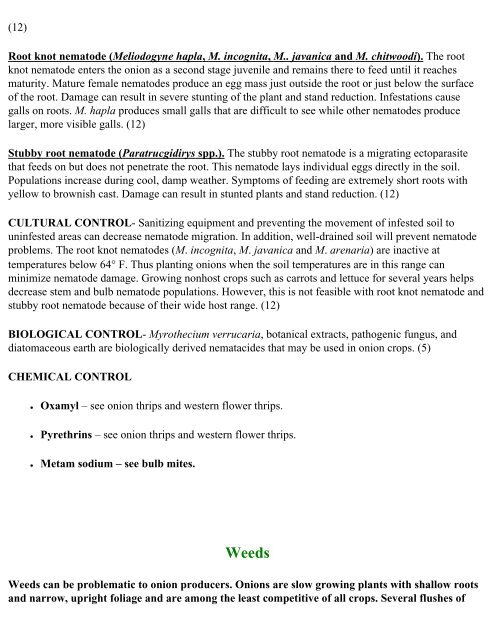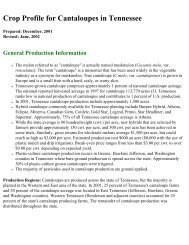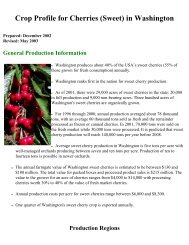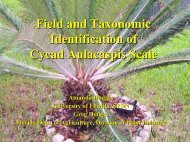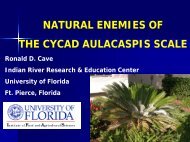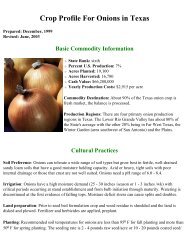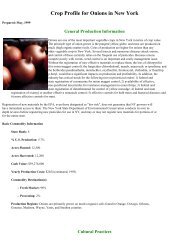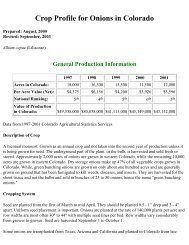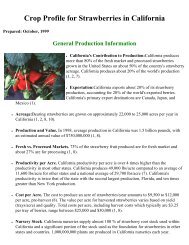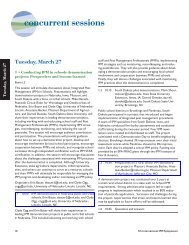Crop Profile for Onions in California - Regional IPM Centers
Crop Profile for Onions in California - Regional IPM Centers
Crop Profile for Onions in California - Regional IPM Centers
You also want an ePaper? Increase the reach of your titles
YUMPU automatically turns print PDFs into web optimized ePapers that Google loves.
(12)<br />
Root knot nematode (Meliodogyne hapla, M. <strong>in</strong>cognita, M.. javanica and M. chitwoodi). The root<br />
knot nematode enters the onion as a second stage juvenile and rema<strong>in</strong>s there to feed until it reaches<br />
maturity. Mature female nematodes produce an egg mass just outside the root or just below the surface<br />
of the root. Damage can result <strong>in</strong> severe stunt<strong>in</strong>g of the plant and stand reduction. Infestations cause<br />
galls on roots. M. hapla produces small galls that are difficult to see while other nematodes produce<br />
larger, more visible galls. (12)<br />
Stubby root nematode (Paratrucgidirys spp.). The stubby root nematode is a migrat<strong>in</strong>g ectoparasite<br />
that feeds on but does not penetrate the root. This nematode lays <strong>in</strong>dividual eggs directly <strong>in</strong> the soil.<br />
Populations <strong>in</strong>crease dur<strong>in</strong>g cool, damp weather. Symptoms of feed<strong>in</strong>g are extremely short roots with<br />
yellow to brownish cast. Damage can result <strong>in</strong> stunted plants and stand reduction. (12)<br />
CULTURAL CONTROL- Sanitiz<strong>in</strong>g equipment and prevent<strong>in</strong>g the movement of <strong>in</strong>fested soil to<br />
un<strong>in</strong>fested areas can decrease nematode migration. In addition, well-dra<strong>in</strong>ed soil will prevent nematode<br />
problems. The root knot nematodes (M. <strong>in</strong>cognita, M. javanica and M. arenaria) are <strong>in</strong>active at<br />
temperatures below 64° F. Thus plant<strong>in</strong>g onions when the soil temperatures are <strong>in</strong> this range can<br />
m<strong>in</strong>imize nematode damage. Grow<strong>in</strong>g nonhost crops such as carrots and lettuce <strong>for</strong> several years helps<br />
decrease stem and bulb nematode populations. However, this is not feasible with root knot nematode and<br />
stubby root nematode because of their wide host range. (12)<br />
BIOLOGICAL CONTROL- Myrothecium verrucaria, botanical extracts, pathogenic fungus, and<br />
diatomaceous earth are biologically derived nematacides that may be used <strong>in</strong> onion crops. (5)<br />
CHEMICAL CONTROL<br />
● Oxamyl – see onion thrips and western flower thrips.<br />
● Pyrethr<strong>in</strong>s – see onion thrips and western flower thrips.<br />
● Metam sodium – see bulb mites.<br />
Weeds<br />
Weeds can be problematic to onion producers. <strong>Onions</strong> are slow grow<strong>in</strong>g plants with shallow roots<br />
and narrow, upright foliage and are among the least competitive of all crops. Several flushes of


